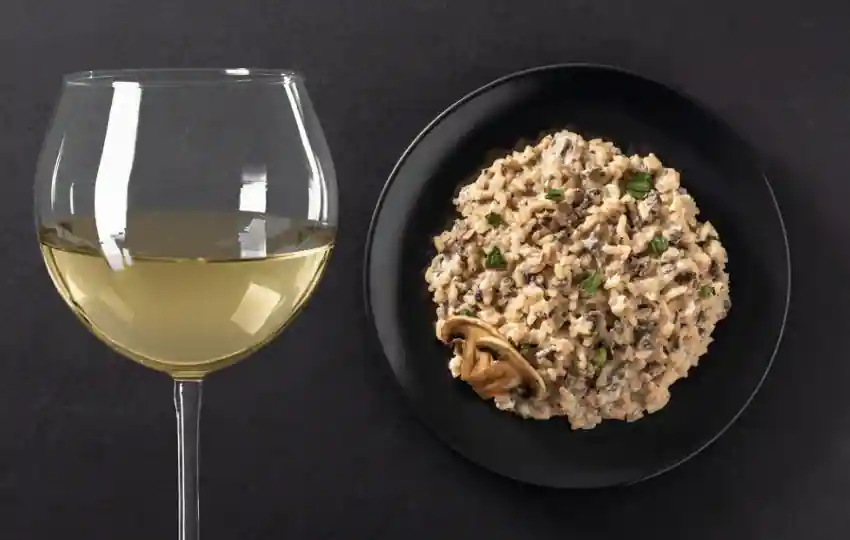Ah, risotto. A dish so delicious, yet so temperamental. Risotto is basically an Italian rice dish cooked in broth until it reaches a creamy consistency. One of the key ingredients in risotto is white wine.
The wine adds acidity and depth of flavor to the dish. However, I understand that not everyone keeps wine on hand (or you don’t drink alcohol).
If you discover yourself in a bind and need a substitute for white wine in risotto, never fear! Here are some common substitutes that will work in a pinch.
Can You Make Risotto without White Wine?
Yes, you can make a delicious risotto without white wine. Instead of using white wine, opt for a low-sodium vegetable or chicken broth to give the dish extra flavor and body.
You may also consider adding other flavorful ingredients such as garlic, onions, herbs, mushrooms, and different types of cheeses to really bring out the flavors.
Additionally, you can use a splash of lemon juice or white wine vinegar to give the dish an acidic kick.
With these alternatives, you can still enjoy a creamy and flavorful risotto without any added alcohol.
Substitute for White Wine in Risotto
1. Lime or Lemon Juice
Lemon juice or vinegar can be used to add acidity to your dish if you are out of both white wine and vermouth.
I would start with 2 tablespoons of lemon juice or vinegar and then add more to taste until you reach the desired level of acidity.
2. White wine vinegar – a good substitute for white wine in risotto
Risotto is a classic Italian dish that typically features white wine. However, not everyone enjoys the taste of wine, and it can also be difficult to find a good quality bottle that pairs well with the other ingredients.
Fortunately, white wine vinegar makes an excellent substitution. It contains a similar acidity to white wine, which helps to balance out the richness of the dish.
Additionally, vinegar can provide a subtle flavor that complements the other ingredients without overpowering them.
When substituting vinegar for wine, be sure to use high-quality vinegar and add it in slowly so that you can adjust the flavor to your liking.
With a little experimentation, you’ll be able to create a delicious risotto that everyone will enjoy.
3. Vermouth
Vermouth is a fortified wine that is often used in martinis. It is similar to white wine in that it is acidic and has a complex flavor.
Vermouth will work well as a substitute for white wine in risotto.

Just use half as much vermouth as you would white wine. For example, if the recipe calls for 1/2 cup of white wine, use 1/4 cup of vermouth instead.
4. Try White grape juice to replace white wine in risotto
White grape juice is a great substitute for white wine because it already has the acidity that you need. It will also add sweetness and depth of flavor to the dish.
Just be sure to use 100% pure grape juice with no added sugar.
5. Dry sherry
A good substitution for white wine in risotto is Dry sherry. You can use it in the same amount as you would use white wine.
It adds a unique flavor to the dish that is slightly sweet and nutty yet still savory. Make sure to use dry sherry, not sweet sherry, for the best results.
6. Water
With a recipe as easy to follow as risotto, there’s no need to get fancy with the ingredients. In this case, water will work just as well as white wine in terms of flavor and consistency.
Simply follow the recipe as written, substituting water for the white wine, and enjoy a delicious bowl of creamy risotto!
7. Canned mushroom liquid – an ideal alternative for white wine in risotto
When it comes to making a classic risotto, there are a few key ingredients that are essential. Of course, you’ll need rice, broth, and Parmesan cheese. But one ingredient that is often overlooked is wine.
Additionally, A dry white wine adds both flavor and acidity to the dish, helping to create a well-rounded flavor profile.
However, not everyone enjoys the taste of wine. If you’re searching for a way to add flavor without the alcohol, consider using canned mushroom liquid instead.
The mushrooms will provide a similar depth of flavor, while the liquid will help to keep the rice moist and creamy. Just be sure to adjust the amount of broth you use accordingly.
However, try using canned mushroom liquid. The result is a slightly earthy flavor that pairs well with mushrooms and Parmesan cheese.
If you’re searching for something a bit lighter, you could also use chicken broth instead of beef or vegetable broth. And for a more robust flavor, try using beef broth.
With a small trial and error, you will definitely be capable of making a delicious risotto that everyone will enjoy.
8. Red Wine
Any experienced cook will tell you that one of the keys to making great risotto is to choose the right wine. While many recipes call for white wine, I prefer to use red wine.
Not only does it add a rich depth of flavor to the dish, but it also helps to bring out the natural flavors of the ingredients.
Red wine is also a great choice for risotto because it doesn’t evaporate as quickly as white wine. This means that you can get a more concentrated flavor without having to add as much wine to the dish.
As a result, your risotto will be more flavorful and enjoyable to eat.
Just be sure to select a red wine that you enjoy drinking, as it will be the dominant flavor in the dish.
So next time you’re in the mood for risotto, reach for a bottle of red wine instead of white. You’ll be glad you did!
Read more: Substitutes for star anise in mulled wine
9. Vodka
Risotto is a delicious Italian dish that typically uses white wine as a key ingredient. However, vodka can also be used to make an excellent risotto.
Vodka has a similar flavor profile to white wine, but it also adds a bit of zing to the dish.
In addition, vodka evaporates quickly when heated, so it doesn’t leave behind any unwanted flavors. As a result, risotto made with vodka can be just as flavorful as traditional risotto but with a bit more depth of flavor.
If you’re looking for something new and exciting, give vodka risotto a try. It’s your new favorite way to make this classic dish.
10. Use Apple Juice instead of white wine in risotto
Apple juice is a great alternative to white wine when making risotto. It adds a sweetness and acidity that helps to balance out the creaminess of the dish.
The juice also contributes to the richness of the flavor, giving the risotto a unique depth that can’t be achieved with other ingredients.
To use apple juice in your risotto, simply replace half or all of the white wine with an equal amount of apple juice.
You may want to adjust the seasonings as well, depending on how sweet you’d like your final product.
With a little experimentation, you can easily create delicious variations on classic recipes—including risotto! Enjoy!
11. Apple Cider Vinegar
Apple cider vinegar is another good option for adding acidity and brightness to the dish. Just be sure to use good-quality apple cider vinegar so that your dish does not end up tasting too vinegary.
12. Coconut water –An excellent substitute for white wine in risotto
Coconut water is an unexpected but surprisingly delicious substitute for white wine in risotto. It adds sweetness and creaminess to the dish without overwhelming it with coconut flavor.
Just make sure that you use unsweetened coconut water so that your risotto doesn’t end up too sweet.
13. Red wine vinegar
Red wine vinegar is a great substitute for white wine in risotto. It has a deep, robust flavor that can add depth and complexity to the dish.
Unlike white wine, which is used primarily as a flavoring agent, red wine vinegar can also provide some acidity and sweetness that can help to balance out the flavors of the risotto.
When using red wine vinegar in place of white wine, be sure to adjust the amount you use according to taste—it may need more or less than what is typically called for in the recipe.
Additionally, if you are making a cream-based risotto such as parmesan or mushroom risotto, be sure not to overdo it with red wine vinegar; too much will make it overly tangy and acidic.
Red wine vinegar is a great way to add complexity and flavor to risotto without adding too much liquid.
Experiment with different amounts and types of vinegar for interesting variations on your favorite recipes. Enjoy!
14. Chicken Broth
Using chicken broth is an easy substitution for white wine because chances are you already have it on hand.
The chicken broth will add flavor and also help to create a creamy consistency. Just be sure to use less salt since the chicken broth is usually quite salty.
Just use the same amount of chicken broth as the recipe calls for white wine.
Additionally, The tradeoff here is that your risotto will be less flavorful since you are losing the acidity and depth of flavor that the white wine would have added.
This is probably the most common substitution for wine in risotto.
15. Gin – a decent replacement for white wine in risotto
Gin is a great way to add an unexpected twist to traditional risotto recipes.
One of the most popular methods to use gin in place of white wine is to replace the traditional wine-based broth with a gin and vegetable stock base.
This delicate, aromatic base gives risotto a fragrant aroma that pairs beautifully with summer vegetables like asparagus, sweet peas, mushrooms, or squash.
To add even more flavor and complexity, try stirring in some freshly grated lemon zest and a few tablespoons of your favorite herbs—basil, oregano, or tarragon work nicely—while cooking.

While cooking, you may also want to consider adding other ingredients, such as sautéed onions or garlic and a pinch of red pepper for added flavor.
The combination of gin and vegetable stock is also a great base for risotto recipes flavored with seafood or rich meats like chicken or duck.
Once your risotto is finished, serve it with fresh herbs, Parmesan cheese, and a spritz of lemon juice to bring out the best flavors of this unique dish.
With just a few easy changes, you can quickly transform traditional risotto into an extraordinary meal that will impress even your most discerning guests.
FAQs on substitute for white wine in risotto
Q1. Is wine essential in risotto?
No, wine is not essential in making risotto. While many recipes will call for a splash of white or red wine to be added to the dish, it can easily be omitted if you do not have any on hand.
To replace the flavor that the wine would provide, consider adding some extra broth and herbs instead.
Additionally, aged balsamic vinegar can also provide a bold, tangy flavor that pairs well with the risotto. Regardless of which option you choose, your dishes will still turn out delicious without the addition of wine!
Q2. Can you skip white wine in risotto?
Yes, you can skip white wine in risotto if you prefer. Risotto is a dish that is traditionally made with white wine to bring out the flavor of the rice and other ingredients. However, it can be made without white wine by substituting a chicken or vegetable broth instead.
If you do opt for this option, make sure to season the risotto with additional herbs and spices to ensure that it still has plenty of flavors.
Additionally, some recipes call for dry sherry instead of white wine for added complexity in the risotto’s taste. You can also experiment with incorporating different types of cheese into your recipe to add more depth and richness to the dish.
Q3. Can you use sherry instead of white wine in risotto?
Yes, you can use sherry instead of white wine in risotto. Sherry is a fortified wine that has been aged, typically with a higher alcohol content than white wine. It offers an intense flavor that works well in savory dishes like risotto.
Generally, it will give the dish more depth and complexity than using plain white wine. However, be sure to choose a quality sherry for cooking, or else your end result could be overly sweet or bitter.
When substituting sherry for white wine, start with half the quantity and add additional amounts as needed depending on your desired flavor profile. You may also want to adjust the seasonings accordingly if you opt for a sweeter variety of sherry. Cheers!

